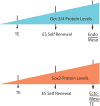Sox2 and Oct-3/4: a versatile pair of master regulators that orchestrate the self-renewal and pluripotency of embryonic stem cells
- PMID: 20016762
- PMCID: PMC2794141
- DOI: 10.1002/wsbm.12
Sox2 and Oct-3/4: a versatile pair of master regulators that orchestrate the self-renewal and pluripotency of embryonic stem cells
Abstract
During the past 10 years, remarkable progress has been made in understanding the transcriptional mechanisms that control the biology of stem cells. Given the importance of stem cells in development, regenerative medicine, and cancer, it is no surprise that the pace of discovery continues to accelerate--paradigm-shifting models proposed only a few years ago are quickly giving way to even more sophisticated models of regulation. This review summarizes some of the major advances made in delineating the roles of two transcription factors, Sox2 and Oct-3/4, in stem cell biology. Additionally, unanswered questions related to their mechanisms of action are discussed. When viewed together, it is evident that Sox2 and Oct-3/4 exhibit the major properties expected of master regulators. They are each essential for mammalian development, they help regulate the transcription of other genes that are essential for development, and they influence their own transcription by both positive and negative feedback loops. Moreover, small changes in the levels of either Sox2 or Oct-3/4 trigger the differentiation of embryonic stem (ES) cells. Thus, each functions as a molecular rheostat to control the self-renewal and pluripotency of ES cells. Overall, understanding how Sox2 and Oct-3/4 function mechanistically will not only provide important insights into stem cells in general, but should also have a significant impact on our understanding of induced pluripotent stem (iPS) cells and, hence, the emerging field of regenerative medicine.
Keywords: ES cells; Oct-3/4; Sox2; iPS cells; molecular rheostat; pluripotency; regenerative medicine; stem cells.
Figures






Similar articles
-
New insights into the control of stem cell pluripotency.Cell Stem Cell. 2008 Jan 10;2(1):4-5. doi: 10.1016/j.stem.2007.12.007. Cell Stem Cell. 2008. PMID: 18371412
-
Embryonic stem cell microRNAs: defining factors in induced pluripotent (iPS) and cancer (CSC) stem cells?Curr Stem Cell Res Ther. 2009 Sep;4(3):168-77. doi: 10.2174/157488809789057400. Curr Stem Cell Res Ther. 2009. PMID: 19492978 Review.
-
Small increases in the level of Sox2 trigger the differentiation of mouse embryonic stem cells.Stem Cells. 2008 Apr;26(4):903-11. doi: 10.1634/stemcells.2007-0951. Epub 2008 Jan 31. Stem Cells. 2008. PMID: 18238855
-
The transcriptional network controlling pluripotency in ES cells.Cold Spring Harb Symp Quant Biol. 2008;73:195-202. doi: 10.1101/sqb.2008.72.001. Cold Spring Harb Symp Quant Biol. 2008. PMID: 19478325 Review.
-
Transcriptional regulatory networks in embryonic stem cells.Cold Spring Harb Symp Quant Biol. 2008;73:203-9. doi: 10.1101/sqb.2008.73.026. Epub 2008 Nov 6. Cold Spring Harb Symp Quant Biol. 2008. PMID: 19022762 Review.
Cited by
-
Characterization of ex vivo cultured neuronal- and glial- like cells from human idiopathic epiretinal membranes.BMC Ophthalmol. 2014 Dec 23;14:165. doi: 10.1186/1471-2415-14-165. BMC Ophthalmol. 2014. PMID: 25540050 Free PMC article.
-
In vivo time-lapse imaging of cell proliferation and differentiation in the optic tectum of Xenopus laevis tadpoles.J Comp Neurol. 2012 Feb 1;520(2):401-33. doi: 10.1002/cne.22795. J Comp Neurol. 2012. PMID: 22113462 Free PMC article.
-
Tamoxifen induces a pluripotency signature in breast cancer cells and human tumors.Mol Oncol. 2015 Nov;9(9):1744-59. doi: 10.1016/j.molonc.2015.05.008. Epub 2015 Jun 5. Mol Oncol. 2015. PMID: 26115764 Free PMC article.
-
Maresin-1 and Resolvin E1 Promote Regenerative Properties of Periodontal Ligament Stem Cells Under Inflammatory Conditions.Front Immunol. 2020 Sep 25;11:585530. doi: 10.3389/fimmu.2020.585530. eCollection 2020. Front Immunol. 2020. PMID: 33101318 Free PMC article.
-
Single-Cell Profiling Identifies Key Pathways Expressed by iPSCs Cultured in Different Commercial Media.iScience. 2018 Sep 28;7:30-39. doi: 10.1016/j.isci.2018.08.016. Epub 2018 Aug 23. iScience. 2018. PMID: 30267684 Free PMC article.
References
-
- Schöler HR, Ruppert S, Suzuki N, Chowdhury K, Gruss P. New type of POU domain in germ line-specific protein Oct-4. Nature. 1990 Mar;344(6265):435–439. - PubMed
-
- Niwa H. Molecular mechanism to maintain stem cell renewal of ES cells. Cell Struct Funct. 2001 Jun;3(26):137–48. - PubMed
-
- Hu T, Liu S, Breiter DR, Wang F, Tang Y, Sun S. Octamer 4 small interfering RNA results in cancer stem cell-like cell apoptosis. Cancer Res. 2008 Aug;68(16):6533–40. - PubMed
-
- Takahashi K, Yamanaka S. Induction of pluripotent stem cells from mouse embryonic and adult fibroblast cultures by defined factors. Cell. 2006 Aug;126(4):663–76. - PubMed
Publication types
MeSH terms
Substances
Grants and funding
LinkOut - more resources
Full Text Sources
Miscellaneous

